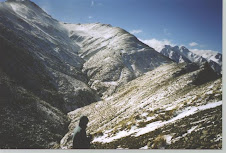Since coming back from the states I have been pretty busy with work. Driving to Wanganui most days, a round trip to the west coast river and sea, not a bad fate. On the recently rare fine days it can be an astonishing drive in late winter/earlyspring. The volcano's lit up in snow covered splendour, Ruapehu, Ngauruhoe, and the not so silent Tongariro, whose recent belches and spurts have closed the world famous Tongariro track and left an egg like stench permeating our North Island when the wind is right. And of course, for me, the grandest sight of all on a fine day, is the white ribbon like satin appearance of the Ruahine stretching away into the north. Calling me gently.
It occurred to me, that not many years ago, I felt this calling quite differently. A hounding need, and quiet desperation to escape. I am still working out exactly from whom, and from what, but driving today I found myself smiling instead of grimacing and plotting to escape as I would have not too many years ago. I found myself thinking of Tara at home, of my boys. And though none of that is anywhere near perfect, indeed not even close, at least I want to be there as well. So to drive along and look at the Ruahine with a broad smile and the patient feelings of "soon enough, soon enough", became a new experience for me. I am 52 and still growing and still learning. From people I love and trust, and who love and trust me, and the wild places I love as well.
Just a couple memories to share.......
Tarn on the Whanahuia.
14 Sept. 2001 Howlett's Hut - main Ruahine range... "What a day! A huge snow storm, blustery winds and cold, but beautiful sunshine and blue skies. It was magical. We climbed up from Daphne hut along the dauntingly steep spur to the range. The snow was at river level even 400 plus metres below, so we relished in climbing through the green ferns, the tawahirauriki coated in snow, and up into the tupare, tough and sturdy brushing the snow off like a man in an overcoat. And as the spur narrowed before the ridge we were amongst a winter wonderland.
Howlett's hut is certainly amongst the most marvelous of any situated in the New Zealand mountains. The Oroua to the west, the Tuki Tuki and Hawkes Bay plains to the east, the full splendour of the main Ruahine range all around. John and I are here alone, a few cups of tea in our favour, and now off to explore the route to Tiraha in the snow. It's wild out there!
Looking back across the Whanahuia and the Oroua valley.
I am always glad I kept these little notebooks. Always a few gems to be revealed. I found one today in the form of words written not by me, but by those I bring into the Ruahine. Mostly American points of view. And if I bring someone into the Ruahine it is for good reason. Here are the words of one such friend, Steve Davidson. I did a crossing with him and my good mate Rich Parduhn, Steve's cousin, back in 2001. It was a nasty weather trip, rain and flooded rivers, cloud obscured tops, the real deal all around. Steve did well. A top man. These are his words...
"Steve Davidson here.. 12/20/01 Visiting with BH from Bayside California.. Tramping, The Ruahine sunset, Maropea Tops, Maropea Forks, Wakelings, Kawhatau river. The next leg in the morning apparently is a vertical drop down to the creek, the river walk and crossings. Checking the flooded depth and rock conditions with your pole. River crossing locations are an art form in indecision. Not too fast of rapids and not too deep. Pool to pool, beach to beach. Every step is important. Tramping is far more difficult than hiking or walking. It involves, walking, hiking, tramping, crawling, and then bashing, and usually in that order. Hiking is pretty easy, tramping is difficult with steep slopes, river drops, the yellow thorn of death (Spaniards), bashing, and even more true is that it does not matter if it its a river, creek, track, or tops. You just find a way. Just get across. Bashing takes more mental and physical prowess. You cannot be afraid. It's only a cliff, or something. No worries. And finally... "Getting your boots wet will be the least of your problems." - the Dobber.
Steve lived. A top bloke indeed.
John by a Spaniard along the Waikamaka. Nasty fauna, but indigenous. They used to be only common on the tops, so to see them here a thousand feet below normal means something.
I shall be in the Ruahine soon enough.
"Somewhere, in the depths of solitude, beyond wilderness and freedom, lay the trap of madness," - Edward Abbey

















